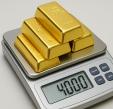Gold rises further, boosted by Chinese data
SINGAPORE (July 15) Gold extended gains on Monday after posting its biggest weekly percentage increase in nearly two years, as fear eased that the US Federal Reserve would wind down its stimulus programme early.
Fed Chairman Ben Bernanke said last week that a highly accommodative policy was needed for the foreseeable future, bolstering bullion, which is often seen as a hedge against inflation.
"People are still buying after Bernanke’s assurance," a Hong Kong-based trader said. "They were expecting the tapering (in stimulus) to begin in September but now they think there is a possibility of it happening only next year."
Prices were also buoyed as Chinese economic growth data for the second quarter matched expectations at 7.5%.
Spot gold had risen 0.1% to $1,285.70 an ounce by 7am GMT, after advancing nearly 5% last week — the most since October 2011. It is still down nearly 25% this year, however.
US gold gained $7 to $1,284.50. Silver, platinum and palladium were all hovering near their highest levels in more than three weeks.
"It’s Bernanke that is still impacting liquidity in the markets," Standard Chartered Bank’s global head of commodities research, Han Pin Hsi, said in Singapore.
"I think we are forming a base (in gold prices) here at current levels. We are still more bullish compared to these prices."
Short-lived rebound
However, other analysts said the rebound in gold prices may not last long.
"Our economists continue to expect the FOMC to taper asset purchases at the September meeting and conclude purchases in March 2014," Barclays analysts wrote in a note on Monday, referring to the Federal Open Market Committee.
"Given our economists’ view and seasonally weak period for demand, we believe the recent rally (in gold) is likely to be short-lived."
Standard Chartered’s Mr Hsi also said outflows from gold exchange-traded funds (ETFs) would have to stop before gold could climb much higher.
Holdings in SPDR Gold Trust, the world’s largest gold-backed ETF, are near four-year lows. The fund has seen outflows of over 13-million ounces, or about $17bn at current prices, so far this year.










